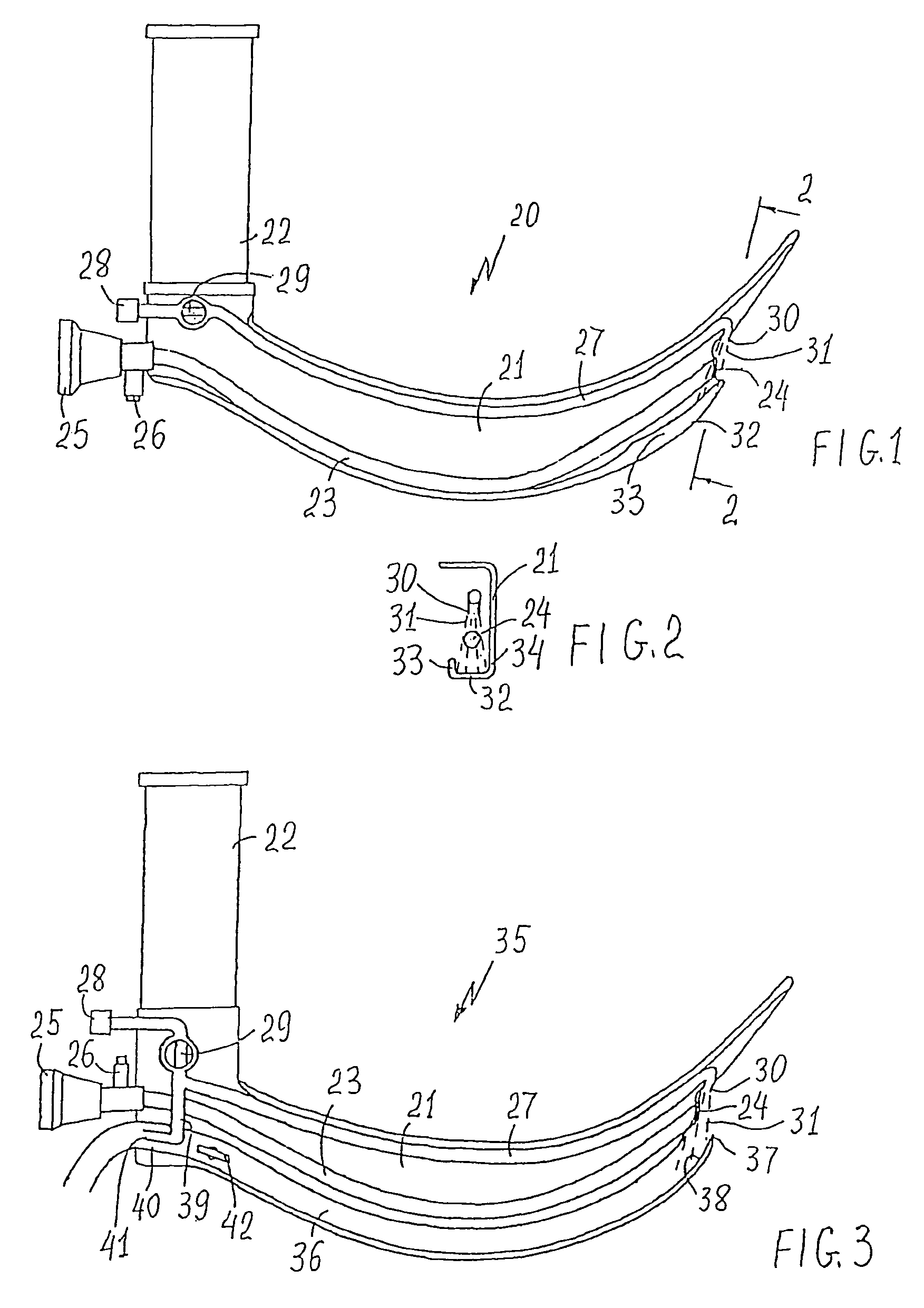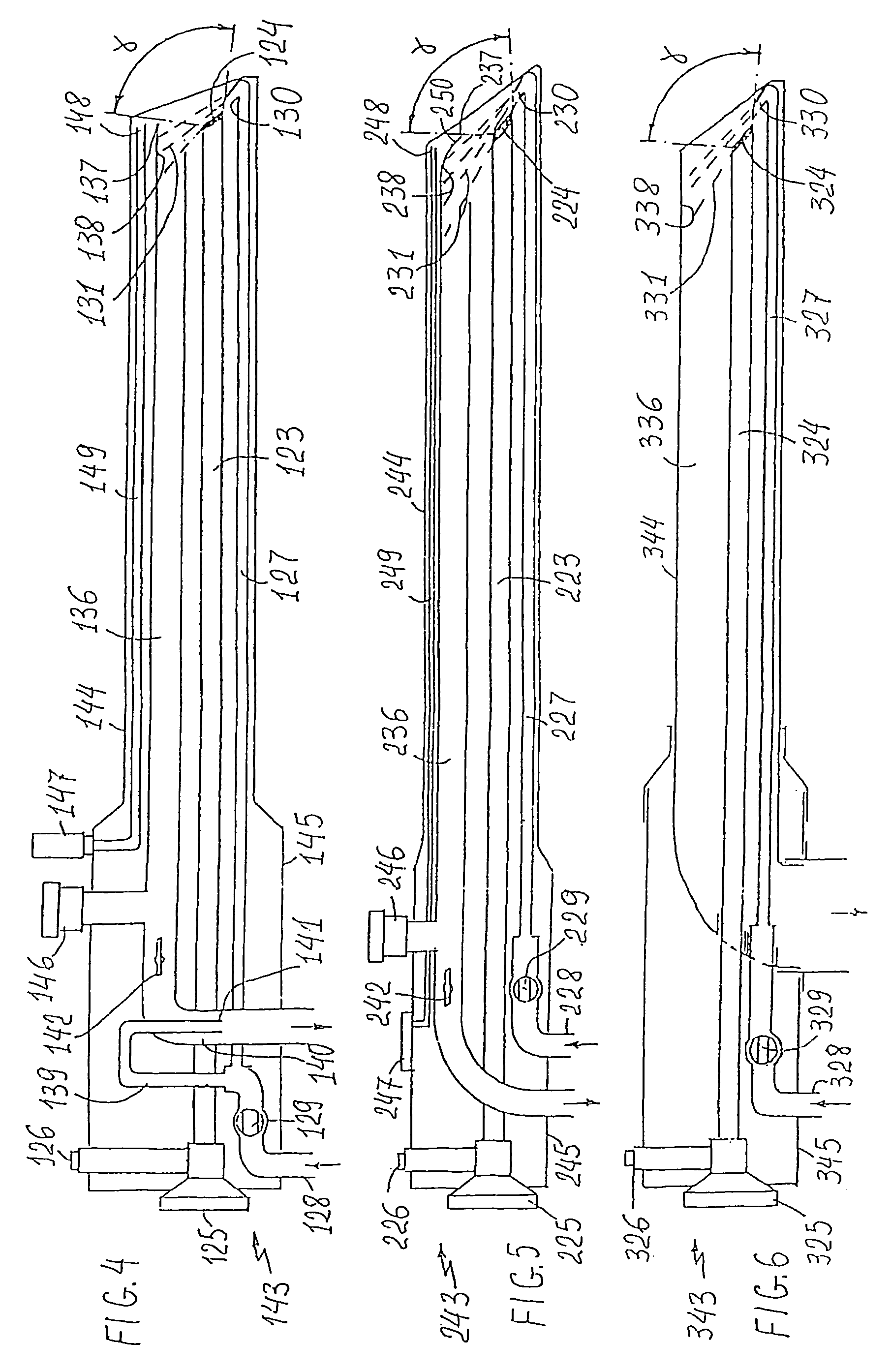The dirtying of the distal optical member surface with patient's secretions such as blood,
mucus, vomit, fat creates significant difficulties for the internal organs visualization.
These problems arise in the cases of bleeding an esophageal and gastrointestinal lesions, bleeding or copious secretions in airways,
colonoscopy for poorly prepared patient,
hysteroscopy during and after
curettage and the like.
Therefore, cleaning the distal optical surface from patient's secretions and
fog is one of the most important problems of current endoscope developments.
The
disadvantage of these endoscopes is low effectiveness of optical
surface cleaning from very
adhesive substances such as blood,
mucus, fat due to low air pressure and the direction of air /
water flow, which does not collide with the optical surface and, therefore, cannot sweep off the
dirt.
The supply of air /
water flow of sufficient pressure is impossible, since this leads to barotrauma of patient internal organs by air /
water jet.
The devices do not have any means for the removal of excessive air / water from
body cavity or for the dissipation of air /
water jet.
Another
disadvantage is excessive complexity and manufacturing cost of the endoscope
system due to the dual (air and water) cleaning system and cumbersome supply and
control system disposed beyond the endoscope device.
Another
disadvantage is the arrangement of air / water
nozzle in front of the optical surface (see U.S. Pat. Nos. 4,509,507, 4,667,655) restricting the vision field of the optical surface.
The disadvantage of this patent is very cumbersome and expensive design due to the dual cleaning system including the numerous equipment disposed outside the endoscope device.
However, upon sufficient air / water
high pressure, the suction means and the barrier do not create a catcher completely able to catch air / water jets and to exclude deflection thereof towards patient internal organs, thus, barotrauma may occur.
Consequently, the capability of the effective cleaning of the optical surface is restricted.
Moreover, during
water supply, the suction means cannot only remove water from a body cavity.
Inevitably, it also sucks in air creating an undesirable (and dangerous) vacuum in the body cavity.
Another disadvantage is the relatively great duration of the cleaning process consisting of washing the distal surface and successively
drying it by air.
This somewhat simplifies the tubing, but complicates the supply
control system.
On the other hand, the gap decreases the vacuum in the path of
airflow going out of the
nozzle and thereby lowers the possibility of its catch and removal.
Thus, the common disadvantages of the endoscope systems with cleaning
optics are: their excessive complexity caused by dual (gas and liquid) cleaning systems and cumbersome and expensive pump and control means disposed outside the endoscope device; low cleaning effectiveness due to low pressure of cleaning fluid (gas and liquid); the absence of effective means for catching and removing the cleaning flow; the absence of reliable control means allowing to adjustment of the pressure in the body cavity required for surgical operations.
However, the device cannot provide cleaning of the optical surface from patient
secretion due to low air pressure.
The device does not comprise any means preventing patient internal organs from barotrauma.
Therefore, its air pressure cannot be increased up to the value sufficient for effective cleaning the optical surface.
However, this
oxygen supply cannot effectively clean the optical surface due to the
low oxygen pressure and the absence of special
oxygen flow directing towards the optical surface.
It is impossible to apply sufficient
oxygen pressure here because the oxygen flow is directed distally and can cause the barotrauma of patient internal organs.
However, the application of
high pressure oxygen for cleaning the optical surface is not disclosed in the prior art.
A main disadvantage of the device is that its application with the endoscope is a very cumbersome, expensive, and inconvenient combination including suction and pressurized
gas supply means,
pressure control system, vacuum and pressure pipes, as well as an endoscope cleaning system with identical equipment.
The disadvantage of known curettage devices is the absence of a visualization means eliminating the capability of operative estimate of curettage results.
This worsens the quality of the procedure, leads to patient traumatization and successive complications, and extends the operation duration.
The application of the visualization means immediately in the curettage device is hampered due to very significant dirtying of the optical surface by curettage products.
Another disadvantage of the curettage devices is the arrangement of the
vacuum pump beyond the curettage device.
This increases the number of communication, heightens the manufacturing cost of the curettage system, and is inconvenient in the operation.
 Login to View More
Login to View More  Login to View More
Login to View More 


